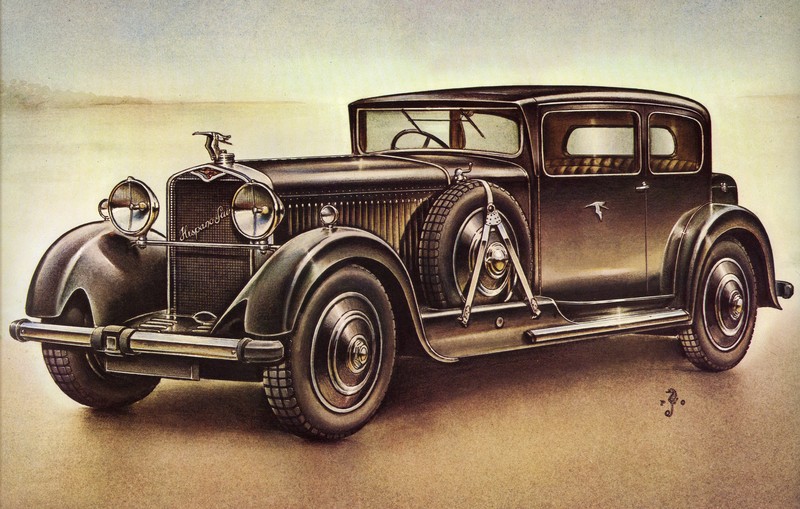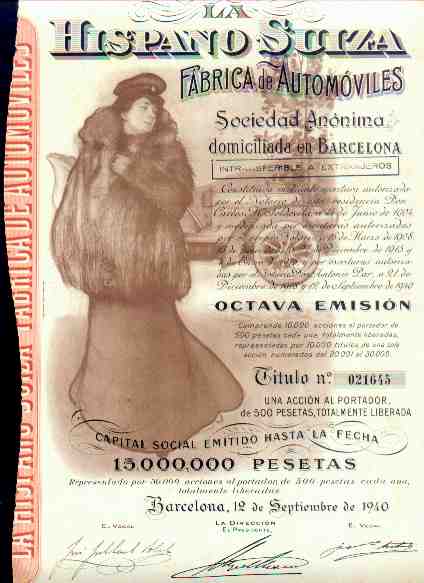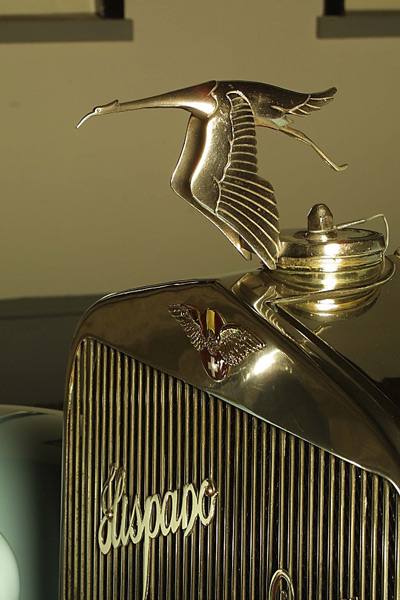HUGO VAN DER MOLEN'S
Scripophily site
a collection of historic bonds
and shares
La Hispano Suiza
Fabrica de Automóviles S.A.
(update .August 18th 2009)
Dr. Hugo H. van der Molen - Wederikweg
114 - 9753 AE Haren, The Netherlands
Tel: +31 (0)50 534 8795; Fax: +31
(0)50 534 0852; email:
[email protected]
See
page on explanations, sales conditions, costs of shipping and on how
to order and to pay.
Paypal, VISA, Euro-Mastercard &
American Express cards are accepted
You are here: home - scripophily - automobiles - Hispano Suiza

Model HC6 uit 1930
bron: www.automobielaandelen.nl
La Hispano Suiza Fabrica de
Automóviles S.A.
English text (zie onder voor Nederlandse tekst)
Established in 1904 in Barcelona, Spain, by Damien Mateu (his signature
can be seen on stocks of the 2nd emission), together with the Swiss engineer
Marc Birkigt (1878-1953) who wanted to introduce in Spain the automobile
series-production, and Francisco Seix. It became a unison of Spanish capital
and Suiss technical genius.
At the Paris automobile salon in 1906 they demonstrated 2 new developments.
In 1910 came the big break through with a special racing car, the Alfonso
VIII (named after the Spanish King). This car was sold so well that already
in 1911 an assembly plant for this car was built near Paris.
During the first world war they engaged in in the building of airplane
engines.
They also produced "Rüstungssparte: Schützenpanzer HS 30"
(= German text).
Between 1919 and 1931 the Hispano-Suiza "H6" was the most expensive
car in Europe.
The 1926 model was the absolute top of automobile manufacturing.
At one time they built into their cars Locheed air pressure brakes,
at that time a sensation in Europe.
In total 6.000 cars were built in Barcelona and 2.600 in Paris, all
very expensive and exclusive.
The company survived the Spanish civil war and kept on producing cars
until 1940.
In 1946 the truck department was taken over by ENASA (Pegaso).
In 1970 the factory stopped its activities. The Suiss company Oerlikon-Bührle
took over a part of the production.

Illustration on the shares:
Standing in front of a car we see a beautiful drawing by Ramon Casas
(1866-1932), famous Spanish artist and portraitist, of his favourite model,
the famous Italian actress Teresa Mariani, wearing a fur coat and a cap.
See
picture of the 8th emission, from 1940, which has no ugly stamps across
the drawing.
There are many emissions of this beautiful share, some with and some
without ugly stamps over the beautiful illustration. They are called 1st,
2nd etc emission. The initial emissions are relatively rare because of
the small numbers issued.
There is also a share from the 7th emission, with overprint "DUPLICADO"
Sources:
Raab auction catalogue, Germany, October 1999, no. 34
F.H.P. auction catalogue, Germany, March 2000, no.869
You can by old Spanish share certificates of Hispano Suiza S.A. and / or letter heads of Hispano Suiza (Nederland) N.V. on our web page with automobile shares and our webpage with automobile letter heads.
Nederlandse tekst
bron: www.automobielaandelen.nl
De Zwitserse ingenieur Marc Birkigt verhuisde omstreeks 1900 naar Barcelona. Hij wist zijn Spaanse werkgever, het bedrijfje La Cuadra, zover te krijgen om kleine series auto’s te bouwen. Het bedrijfje ging failliet, de grootste schuldeiser, J. Castro, verwierf de boedel en liet de autoproductie in kleine series, onder zijn naam weer beginnen. Door geldgebrek kwam er een einde aan de onderneming en ditmaal werd de zaak overgenomen door een man met visie, Damien Mateu. Hij maakte er in 1904 de “Hispano Suiza Fabrica de Automovils” van. De naam wees op het samengaan van Zwitserse kennis met Spaans kapitaal. In 1907 kocht de jonge Spaanse koning Alfonso XIII de eerste van de ongeveer dertig Hispano Suiza’s die in zijn bezit zouden komen. Het merk maakte in 1909 zijn wedstrijddebuut in de race om de beker van Catalonië en in 1910 won een Hispano Suiza de Coupe des Voiturettes. Op de Brookland baan werden met het onvergetelijke model “Alfonso” snelheden van meer dan 120 km/h gereden. Dit model bracht het merk zoveel internationale roem, dat in 1911 een assemblagefabriek werd gebouwd in Levallois-Perret bij Parijs. Het modebewuste Franse publiek werd van daaruit bediend. Birkigt experimenteerde ook met compressoren, maar zonder veel succes. Na 1913 deed de fabriek nauwelijks nog aan wedstrijden mee. De Franse Hispano Suiza fabriek verhuisde in 1914 naar een grotere fabriek in het nabijgelegen Bois-Colombes. In de 1e wereldoorlog bouwde Hispano Suiza beroemde vliegtuigmotoren voor de geallieerde gevechtsvliegtuigen. Uit Frankrijk kwam het embleem met de vliegende ooievaar, gebaseerd op het squadronvignet van Frankrijks grootste jachtvlieger, Georges Guynemer, met z’n SPAD-vliegtuig met Hispano Suiza motor. Van 1919 tot 1931 werd het type H6 gebouwd, dit was de duurste Europese auto. Daarne moest de J12 nog exclusiever worden. In Tjechoslowakije bouwde Skoda van 1924 tot 1927 Hispano Suiza’s in licentie. In 1931 nam het merk de Ballot fabriek over. De Franse fabriek staakt de autoproductie in 1939 en ging zich toeleggen op de winstgevender productie van wapens en vliegtuigmotoren. In Barcelona ging men door met de fabricage van automobielen tot 1943 en de Spaanse fabriek werd overgenomen door vrachtwagenfabrikant Pegaso. Vroeg in de vijftiger jaren kwam de Spaanse fabriek nog met de sportwagen Pegaso, maar deze sloeg niet erg aan. Na een fusie met Bugatti in 1963, werd het bedrijf een belangrijk onderdeel van de Franse luchtvaartindustrie. Tegenwoordig behoort Hispano Suiza tot de Zwitserse wapenproducent Oerlikon-Bührle. In Barcelona werden totaal 6.000 auto’s gebouwd en in Parijs 2.600.
bron: www.automobielaandelen.nl
Created on 22-07-06, last changed on 14-04-07.
De Spaans/Zwitserse automobielfabriek Hispana-Suiza had een ooievaar als mascotte, een ontwerp van de beeldhouwer François-Victor Bazin uit 1919. Bazin heeft vele mascottes ontworpen. De ooievaarmascotte, die in twee maten werd uitgevoerd, was een eerbetoon aan de Franse piloot en oorlogsheld kapitein Georges Guynemer. Op de romp van de vliegtuigen van zijn squadron Escadrille N3 was een ooievaar geschilderd. De al jong onderscheiden Guynemer kwam tijdens de Eerste Wereldoorlog op 23-jarige leeftijd om het leven in een zwaar luchtgevecht. Als nationale held werd hij bijgezet in het Panthéon in Parijs. De vliegtuigmotoren waren van Hispana-Suiza. Na de oorlog vervaardigde deze van oorsprong vliegtuigmotorenfabrikant alleen nog auto's, waarvan de H6 Hispano-Suiza 6.5 liter 6 cilinder de snelste, meest geavanceerde en luxueuze auto van Europa was. Hij werd voorzien van de ooievaar.
bron: http://www.zilverbank.nl/cachet/15_pronken_met_een_mascotte.shtml
d.d. 18-8-2009 |
|
.. |
.


